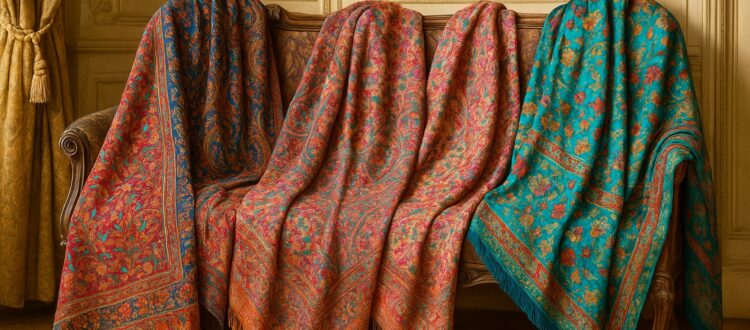Eco-Luxury Fashion: Why Vintage Indian Shawls Are Sustainable Treasures
In today’s eco-conscious world, making sustainable fashion choices is becoming more and more important. Luxury today is being redefined. It is no longer only about designer labels and price tags. As the world grapples with climate change, sustainability, and responsible consumption, a new wave of luxury has emerged: eco-luxury. Among the most exquisite examples of this new “eco-luxury” movement are vintage Indian shawls, timeless pieces of sustainable treasures that combine craftsmanship with conscious living.
The whisper of silk against skin, the intricate dance of woollen threads that tell centuries-old stories, this is the magic of Indian textiles.
From the beautiful handwoven shawls of Kashmir to the elegant and timeless Kani shawls, Indian textiles have always produced eco-friendly shawls.
These aren’t just accessories; they’re sustainable treasures that carry centuries of tradition while responding to the demands of today’s eco-conscious fashion world.
Sustainability isn’t simply about what’s new—sometimes it’s about honouring the past. Vintage Indian shawls, like the traditional Pashmina shawls or the timeless Jamavar shawls, and others, with centuries of craftsmanship woven into every fibre, are sustainable treasures that embody both elegance and ethical luxury.

Also Read: Top 10 Types Of Indian Shawls
The Rise of Sustainable Fashion
The fashion industry as a whole is undergoing a rapid change. With eco-consciousness on the rise, people are demanding sustainable practices in every walk of life. Fast fashion is no longer seen as glamorous; instead, it has become symbolic of mass waste, pollution, and exploitation. This growing awareness has fuelled a demand for alternatives – for clothing that tells a better story. Shoppers are actively seeking brands committed to ethical production, eco-friendly materials, and longevity.
Several core trends explain why sustainable fashion is rising:
- Conscious consumers: Gen Z and Millennials are increasingly prioritizing eco-friendly and ethical practices in their purchases.
- Luxury redefined: Instead of buying mass-produced items, top fashion circles are gravitating toward fewer, better-made pieces with lasting value.
- Circular fashion: Vintage and pre-owned textiles are celebrated as they extend the lifecycle of garments and reduce waste.
https://www.youtube.com/watch?v=P1Qo8JOMYjs
Video Credit: The Pumpkkin Entertainment
Indian Shawls: Sustainable Treasures

In this rapidly changing fashion industry, Indian textiles have become a beacon of eco-friendly fashion treasure. This growing awareness of protecting our environment has led to people gravitating to sustainable textiles like vintage Indian shawls. For centuries, it has produced handwoven fabrics that travelled across continents and fascinated royalty and collectors alike. Among its crown jewels are shawls—especially Pashmina shawls, Jamawar shawls, and intricately embroidered Kani shawls.
Sustainable Indian Shawls: How are they eco-friendly?
The Vintage Indian shawl – a prime example of sustainable luxury at its finest. These aren’t just accessories; they are wearable art, each piece a testament to generations of skill, patience, and natural artistry.
- Natural Fibres, Minimal Waste
Traditional Indian textiles are made from natural fibres. Think Pashmina wool, silk and other such organic materials. These are biodegradable, eco-friendly fibres that leave no toxic footprint behind. These materials are harvested ethically, and they are created through an entirely eco-friendly process.
- Longevity and Durability
Unlike mass-produced items designed to be discarded, vintage Indian shawls were crafted to last. Made from high-quality natural fibres like pashmina, cashmere, silk, and fine wool, and often handwoven with incredible precision, these shawls were considered heirlooms. Their inherent durability means they resist wear and tear, ensuring a lifespan that can span decades, even centuries, with proper care. This directly combats the “throwaway” culture of fast fashion.
- Circular Economy at its Best
By acquiring a vintage shawl, you’re participating in a truly circular economy. You’re giving a pre-existing item a new lease on life, preventing it from ending up in a landfill. This reduces the demand for new production, conserving resources, energy, and water that would otherwise be used to create a new garment.
- Natural Dyes

These traditional Indian shawls use natural dyes. Historically, dyes were also natural, derived from plants, minerals, and insects, further reducing the chemical footprint often associated with modern textile production. Even if some pieces used synthetic dyes, their longevity means that the impact is spread out over many, many years.
- Preserving Craftsmanship, Not Exploiting Labour
Vintage pieces inherently support traditional artisanal skills. While the original makers of a vintage shawl are no longer creating it, purchasing and appreciating these items helps to maintain interest in these ancient crafts, indirectly encouraging the continuation of such skills in contemporary ethical production. It’s a silent nod of respect to the artisans who poured their lives into these creations, far removed from the exploitative practices often found in today’s fast fashion supply chains.
- Timeless Style, Beyond Trends
True sustainability is also about timelessness. Vintage Indian shawls possess an enduring aesthetic that transcends fleeting trends. Their classic designs, intricate patterns, and rich colour palettes ensure they remain stylish year after year, offering versatile elegance that can be dressed up or down. This eliminates the need to constantly buy new items to keep up with changing fads.
Why Vintage Indian Shawls Represent Eco-Luxury

- Heritage Value: Every shawl carries stories of artisanship from Kashmir to Banaras.
- Rarity: Many weaving techniques are endangered, making each vintage piece an irreplaceable collectible.
- Sustainability: Buying vintage is the ultimate form of sustainable consumption—no new resources are exploited.
- Investment Appeal: High-quality vintage shawls often appreciate in value, making them as much financial assets as wearable art.
How Can We Encourage Eco-Friendly Shawls
Encouraging the use and collection of eco-friendly shawls is more than a fashion statement; it’s a cultural and ecological responsibility.
- Preserving Craftsmanship: Supporting vintage and handwoven shawls ensures traditional skills aren’t lost, and this provides the necessary support to local artisans.
- Reducing Waste: Every time a vintage shawl is reused or resold, it prevents waste and reduces the demand for unsustainable mass production. This prevents mass landfills, filled with discarded and used textiles.
- Empowering Artisans: The vintage market and ethical sourcing create continued demand for artisans and weaving communities, giving them fair recognition.
- Educating Consumers: Collectors and buyers become ambassadors of conscious luxury, spreading awareness about sustainable alternatives.
Giftex: A World of Collectibles Auction
Are you looking to adorn yourself or your loved ones with authentic vintage textiles? Then Giftex: ‘A World of Collectibles’ auction is the place for you. Look forward to textile treasures from elegant shawls to vintage carpets, rugs and more. Stay tuned for more information on upcoming auctions.
Conclusion: Wrapping Yourself in Sustainability
Vintage Indian shawls aren’t just accessories; they’re legacies woven with care, skill, and sustainability. In a world drowning in fast fashion, these shawls remind us that true luxury is timeless, responsible, and soulful. By choosing a vintage Indian shawl, one simultaneously reduces fashion waste, supports cultural preservation, and invests in luxury that outlives trends. They are not merely garments to be worn but stories to be lived, treasures to be cherished, and legacies to be handed down.
So, the next time you wrap yourself in a vintage Indian shawl, know that you are embracing more than warmth—you are embracing eco-luxury at its finest.






